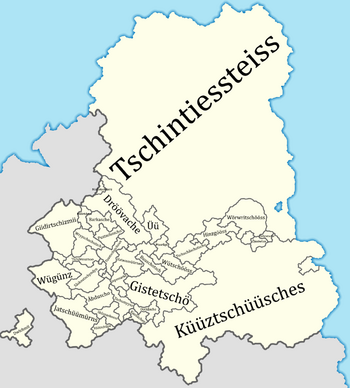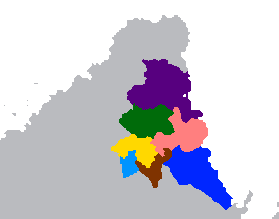Gintem Confederation
Gintem Confederation gen-she-den-rós-cin-de-den Genschedenrööss Hindeden | |
|---|---|
Motto: ‘We rise’ | |
 | |
| Capital | X |
| Official languages | Tschintierst Classical Doccábh (3399 CY – 3521 CY) |
| Recognised regional languages | Dröövache Parutschan Tschuchåschotscho Parutschan |
| Demonym(s) | Gintem |
| Government | Mixed confederal intergovernmental elective constitutional monarchy |
| Ytytschooryn Wechtachz | |
| Legislature | United Council of the Various Lands of the Gintem Confederation |
| Noble Council | |
| Common Council | |
List of countries within the Gintem
| |
| Area | |
• | 709,848.16 km2 (274,073.91 sq mi) |
| Population | |
• Estimate | 82,754,548 |
• Density | 117/km2 (303.0/sq mi) |
| This article is part of a series on |
| Gintem culture |
|---|
 |
| Countries |
| Languages |
| Religion |
| History |
| Culture |
| Related topics |
|
|
The Gintem Confederation (/ˈgɪntɛm/) is an association of 33 Tschintierst-speaking countries located in Northeast Yazland. The confederation covers and area of 709,848 km2 (274,074 sq mi) and has a combined population of X million people, not including overseas colonies of member states. The confederation has existed in some form since the fall of the Doccábhan Empire and Sendeasta Missísin’s division of its lands to the various Gintem tribal rulers. Since its formation the Gintem has been a powerful thorn in the side of various North Yazland nations, banding together to prevent any large scale outside attack, but constantly squabbling from within. The confederation is unique among organizations, being not a state, but also not a mere alliance; existing to mediate the various disputes between the rulers of the states that reside within it. In its modern form it has also served as a way to interact economically and politically with the various small states of the confederation without doing so individually, though states such as TSC and KSC still operate functionally independently of the confederation.
History
Doccábh-Gintem Wars
Collapse of the Doccábhan Empire and founding

Following the fall of the Doccábhan Empire, the Gintem Confederation would conquer much of the land on the Eastern Side of the Grese Mountains. The official founding of the Confederation would be in 3356 CY, though it had existed in a loose form for decades prior. Sendeasta Missisin would be elected as the first Archqueen Paramount of the Gintem Confederation, she would go on to add more land into the Gintem through the conquest of various Doccábhan remnant states, redistributing land to Gintem peoples following conquest. Missisin would die in 3397 CY with no biological heirs, and her lands in the Gintem Confederation would be split amongst various nobles. This would establish the tradition of Missisinic succession within the Gintem Confederation, whereupon the death of a monarch, a vote could be called by the Noble Council to split their land among various landowning successors. Maircességte the Great would succeed Missisin as Archking Paramount, and would institute numerous reforms to the confederation, establishing the Noble Council and the Common Council, as well as rolling back some of the anti-Doccábh edicts of Missisin's reign. Maircességte would also make Classical Doccábh the official literary language of the Confederation in 3399 CY, and records would be recorded primarily through Classical Doccábh for a century. Conquest of land from more Doccábhan remnant states would see the outbreak of disputes between the various member states of the confederation, and an eventual conflict in the Three Kings' War of 3411 CY. The war would see the Kingdom of Üü and the Duchy of Jatschüümürns come into conflict with the Kingdom of Gistetschö and the Kingdom of Tschurskyyjo. Maircességte would bring the war to an end in 3415 CY after the devastation proved too great. The war would see the Kingdom of Üü propelled into being the largest power of the confederation, and their King X would make an attempt for the position Archking Paramount after Maircességte's death in 3420. This would be thwarted by a bloc of anti-Üü voters in Gistetschö, Vrishia, Kriibüsche, Mödwritschööss, and Tschurskyyjo, and X of Kriibüsche would be elected instead. Following the death of X in 3432, Üü it would be subject to a Missisinic succession called by the Archking Paramount and his supporters, drastically reducing its size and influence.

Early Medieval history
Despite being within the winning side of the coalition against Üü, the King of Vrishia would grow concerned with the use of Missisinic succession within the confederation, and urged the Archking Paramount to use it as a last resort when no valid heirs are available. Archking Paramount X brushed off these concerns, and when the King of Vrishia became convinced his concerns would not be heard, he decided Vrishia would leave the Gintem Confederation. The legality of leaving the confederation had never been settled, so the result was Archking Paramount X arguing that the King of Vrishia had committed an act of treachery, while the King of Vrishia argued there was no law preventing him from leaving. The result was the Vrishtic War of 3438, where Vrishia would fight against Archking Paramount X and is allies for its independence. The war ended in 3443 as a Vrishtic victory, and the Gintem Confederation would permanently lose Vrishia as a member. After this war, Archking Paramount X would make it officially illegal to leave the confederation without a majority vote. Archking Paramount X would become unpopular throughout the confederation, and following his death in 3451, X of Üü would be elected as Archking Paramount. X would enact Missisinic succession on the states of Gistetschö, Tschurskyyjo, and Kriibüsche during his reign as Archking Paramount, cementing a decades-long feud between the states of Gistetschö and Üü. Following the death of Archking Paramount X in 3463, Missisinic succession would fall out of fashion, being perceived as a tyrannical power. Following the election of Archking Paramount X, Missisinic succession would be outlawed except in cases of open rebellion against the Archking Paramount or when a king died without a viable heir. The Gintem Confederation would remain mostly static for several years until tensions between the Duchy of Tschåchrumnooss and the Kingdom of Marküüche over a border fortress exploded into Tschüpeesta's War in 3474. Calls for peace and intervention by other members of the confederation would be met with indifference by Archking Paramount X, who allowed the war to go on until its conclusion in 3479. In 3481, the Gintem would be invaded by the Empire of Vahtyas. The leader(s?) of Vahtyas, having descended from Doccábhan imperial remnants, sought to reclaim what they viewed as their homeland. This mark the beginning of the Wars of the Birthright, a 20 year long military conflict between the various states of the Gintem Confederation and the Empire of Vahtyas. Most fighting would take place in Jatschüümürns, Tschurskyyjo, and Mödwritschööss, seeing the southern half of the confederation devastated by frequent raids and warfare. X. The conflict would end inconclusively in 3501 CY, seeing lands in Jatschüümürns and Mödwritschööss ceded to the Empire of Vahtyas, but with the leader(s?) of Vahtyas ultimately failing in their goal to reclaim the lands of the Gintem. Duke Artüwend of Jatschüümürns would be elevated to the status of King for his contributions in the Wars of the Birthright. The Kingdom of Üü would also be split in two in 3496, after the previous king left the kingdom to his two sons. The Gintem would once again remain at peace following the Wars of the Birthright.
Grand Conquests
Following the Wars of the Birthright and the ensuing peace veterans of the war, nobles and soldiers alike, would grow restless. A cultural atmosphere would develop around pursuing tales of glory like those of the Battle of Siirsüüsz, and bands of glory-seekers would begin to march outside the borders of the Gintem to claim lands of their own in battle. The decaying power of the Late Doccábhan Empire made for an easy target, and the last remnants of their government and leadership would eventually be destroyed by these events. The Grand Conquests would start in the early 36th century and would lead to the founding of several border territories within the Gintem, including the Margravate of Tschintiessteiss in 3516 CY. Several nobles would also conquer new holdings and leave the old ones to relatives. It's unknown when exactly this process started, but by the mid 36th-century several new states had been founded, and several moved. The Grand Conquests would also coincide with the diminishing of power held by the Archking Paramount, following the Rebellion of 3543 and the partition of the Duchy of Sküschasche, new reforms would be instituted in the confederation severely limiting imperial power. This would lead to a chaotic mess of infighting states which the Archking Paramount would inevitably be unable to stop. This period of anarchy would see warfare between member states become common and prevalent, and borders would change by the decade. By around 3580, the Grand Conquests would come to a close as the member state count of the Confederation would nearly quadruple from 17 member states to 78.
War of Two Kingdoms
Gistetschö and Hinzgööss have a tussle between 3590 and 3600 CY
King Daghi's Wars
By 3600 CY, Gintem states would begin to encroach on and conquer into traditionally Dhimze territories, taking lands from the Barony of Jvuzrada-Niksjvuzri in the [something war]. This shift in the balance of power in Dhimrai would allow Daghi III of Ganipara to rise in power, uniting the shattered baronies of Dhimrai in 3615 CY under an alliance. Intent on taking back lands lost to the Gintem, Daghi III would lead an invasion of the states of Hinütschistschen, Maarküche, Såskybuutscho, and Schödschüchachen in 3617 CY. Archking Paramount X would call for the defense of the entire confederation, but the various rulers were more concerned over their own internal struggles than the war with Dhimrai. The Margravate of Tschintiessteiss would be the only outside state to join in the defense against Daghi III. Daghi III would be immensely successful in his efforts, defeating the disorganized coalition in numerous battles, holding lands traditionally held by the confederation. A peace was called on 3620 CY, leading to the reclamation of Dhimrai’s previous land as well as new lands ceded by the confederation. In 3628, the coalition would attempt to tear down King Daghi III with a more organized assault, yet despite being severely outnumbered, Daghi III would once again win a major victory at the Battle of X, and would push all the way to Tschintiessteiss. In 3633 CY, Margrave Tschantachzü I would make a last stand against the forces of Daghi III in the Battle of X. Though the battle itself was a costly stalemate, Daghi III would perish in the fight, leaving the Dhimze army leaderless and demoralized. Dhimrai would be pushed back and forced to make peace in 3639 CY. Ultimately ending with the conquered Dhimze lands being returned, and the occupied Gintem lands being returned to The confederation.
Düjaskeer Contention
In 3683 CY, the Duke of Düjaskeer, X, was overthrown by his brother, X, following a brief civil war. The former Duke would then flee to the Kingdom of Gistetschö to seek support from King X, claiming his brother overthrew him with the support of the King of Küüztschüüsches. The King of Gistetschö, in an attempt to curb the rising power of Küüztschüüsches within the confederation and to prevent any possible Küüztschüüsch Archking Paramounts, would enlist the help of of the King of Jatschüümürns to curb the power of KSC. They would declare war on KSC and Düjaskeer in 3684 CY, much to the surprise of the King of KSC, who found the King of Gistetschö's reasoning to be baffling. X. The war would come to a close in 3690 CY, where the Kingdoms of Gistetschö and Jatschüümürns would yield significant amounts of land and power to KSC and Düjaskeer. The end of this war would begin to cement the Kingdoms of Üü and KSC as the two preeminent powers of the Gintem Confederation. X
Something
In 3693 due to escalating border tensions between the Baronies of Dhimrai and the states of the Gintem Confederation, the Ariani Msrovs I and Archking Paramount X signed the Treaty of Mqarr. Settling the disputes with a land exchange between the various Baronies and the states of the Gintem. X

